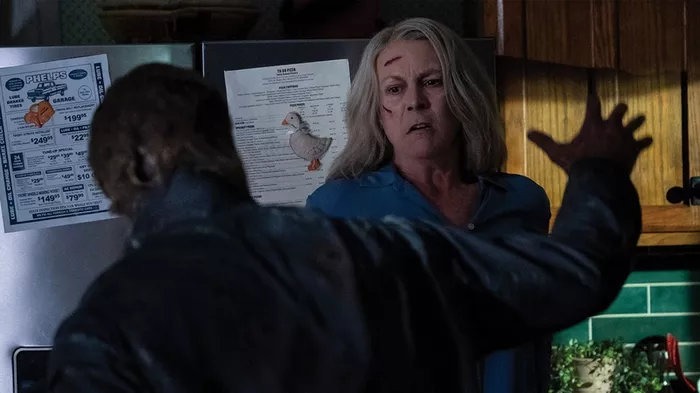Michael Myers, the iconic embodiment of terror and relentless pursuit in the Halloween franchise, has long captivated audiences with his enigmatic motives and insatiable obsession with targeting Laurie Strode. As the narrative unfolds, the sinister dynamic between Michael and Laurie evolves into a chilling battle of wits and strength, underscoring the enduring mystery surrounding the origins of Michael’s fixation on his unsuspecting prey. Amidst the labyrinth of theories and speculations that seek to decipher the enigma of Michael Myers’ motives, the haunting allure of his relentless pursuit of Laurie Strode serves as a chilling reminder of the enduring legacy of one of horror cinema’s most iconic villains.
1. The Evolving Obsession: Michael Myers’ Battle of Wits
At the core of the enigmatic narrative lies the evolving obsession that consumes Michael Myers, as his relentless pursuit of Laurie Strode transcends the realms of mere vengeance and delves into the intricate nuances of a chilling battle of wits and strength. Over time, Laurie’s resilience and tenacity render her increasingly difficult to kill, thereby elevating their sinister cat-and-mouse dynamic to unprecedented heights of psychological warfare. The evolving obsession that fuels Michael’s relentless pursuit of Laurie serves as a haunting exploration of the enduring clash between predator and prey, underscoring the profound depths of the human psyche and the enduring legacy of one of horror cinema’s most enduring and iconic rivalries.
2. The Annie Theory: Unveiling the Initial Target
A compelling theory that has pervaded the discourse surrounding Michael Myers’ motives proposes that Laurie Strode was not originally intended to be his primary target. Instead, the theory suggests that Michael’s initial fixation centered on Laurie’s friend, Annie, whose presence inadvertently set in motion a sequence of events that would culminate in Laurie becoming the unwitting focus of Michael’s malevolent intentions. The Annie Theory serves as a poignant reminder of the intricate web of fate and circumstance that often shapes the trajectories of horror narratives, highlighting the pivotal role of chance and happenstance in dictating the fates of both victims and predators in the haunting tapestry of the Halloween franchise.
3. The Childhood Home Theory: Unearthing the Trigger
Amidst the labyrinth of theories and conjectures, another compelling proposition emerges, positing that Laurie Strode became the focal point of Michael Myers’ murderous rampage due to her inadvertent disturbance of his childhood home. The Childhood Home Theory underscores the profound impact of psychological trauma and unresolved childhood experiences on the psyche of a malevolent force, weaving a haunting narrative that explores the enduring legacy of unresolved trauma and the indelible mark it leaves on the fragile fabric of the human psyche. The notion that Laurie’s actions unwittingly triggered Michael’s descent into a relentless pursuit of vengeance serves as a poignant allegory for the enduring power of unresolved trauma and the haunting specter of the past that continues to shape the destinies of both predator and prey.
4. The Enduring Legacy of Terror
As the discourse surrounding Michael Myers’ motives in targeting Laurie Strode continues to evolve, the enduring legacy of the Halloween franchise stands as a testament to the enduring allure of one of horror cinema’s most iconic villains. Through the haunting interplay of psychological warfare, relentless pursuit, and the enduring legacy of trauma and vengeance, the narrative of Michael Myers and Laurie Strode serves as a chilling reminder of the enduring power of fear and the indomitable spirit of survival that continues to resonate with audiences across generations. In the hallowed annals of horror cinema, the enigmatic motives of Michael Myers and his relentless pursuit of Laurie Strode stand as a poignant allegory for the enduring struggle between light and darkness, innocence and malevolence, underscoring the eternal battle for redemption and survival that echoes through the corridors of time.
Conclusion
In the enduring legacy of the Halloween franchise, the enigmatic motives of Michael Myers in targeting Laurie Strode serve as a haunting exploration of the enduring legacy of trauma, vengeance, and the indomitable spirit of survival. Through the chilling interplay of psychological warfare, chance encounters, and the enduring specter of unresolved childhood trauma, the narrative of Michael Myers and Laurie Strode transcends the boundaries of cinematic horror, resonating with audiences across generations and leaving an indelible mark on the annals of horror cinema. As the enigma of Michael Myers’ motives continues to captivate audiences, the enduring legacy of the Halloween franchise stands as a testament to the enduring power of fear, the resilience of the human spirit, and the eternal struggle between light and darkness that continues to define the timeless allure of one of horror cinema’s most iconic and enduring rivalries.

